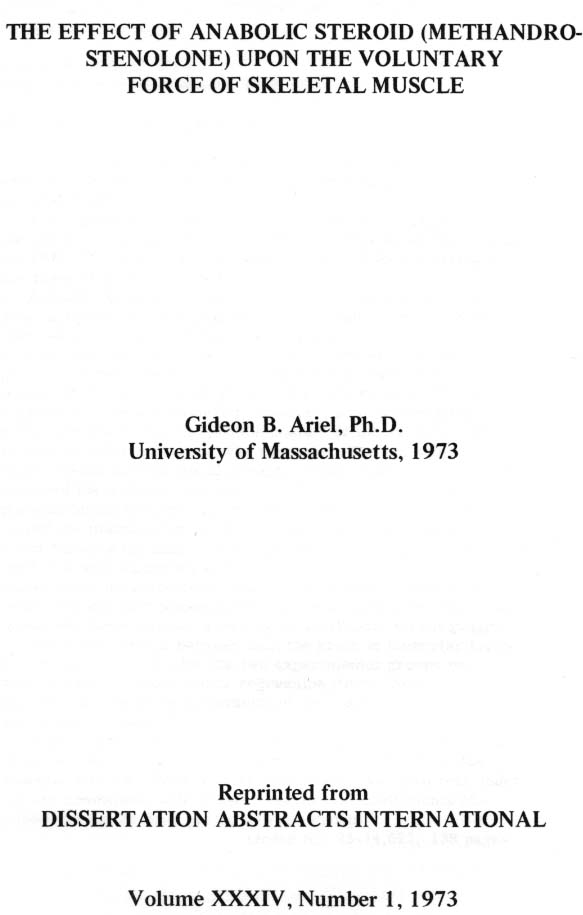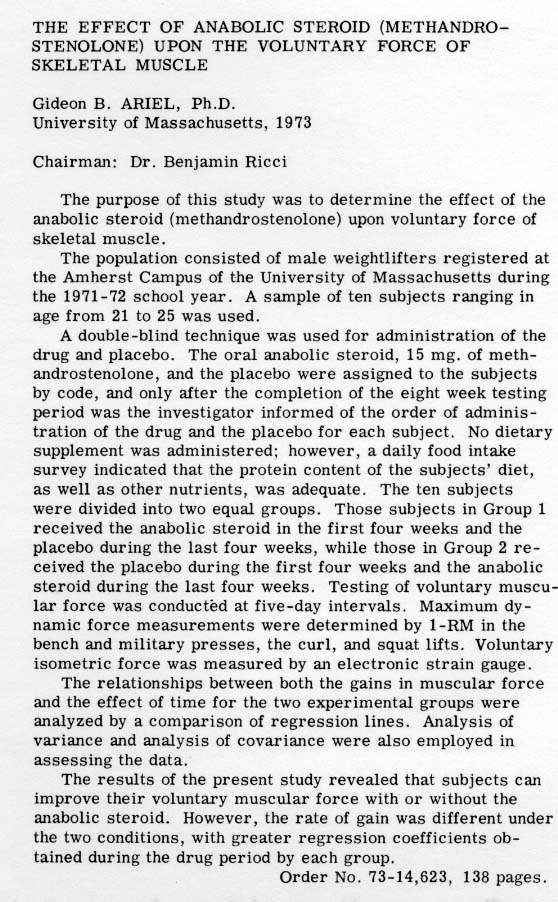The Effect of Anabolic Steroid (Methandrostenolone) Upon the Voluntary Force of Skeletal Muscle
First Anabolic Steroid study conducted wit Olympic Athletes (Steroids were legal at that time)
By Gideon Ariel in Dissertation Abstracts International on Thursday, February 1, 1973
Article Synopsis
This article, "The Effect of Anabolic Steroid (Methandrostenolone) Upon the Voluntary Force of Skeletal Muscle", is a study conducted by Gideon B. Ariel, Ph.D. at the University of Massachusetts in 1973. The study aimed to determine the impact of the anabolic steroid, methandrostenolone, on the voluntary force of skeletal muscle.
The study involved ten male weightlifters from the University of Massachusetts, aged between 21 to 25. The subjects were divided into two groups and were given either the anabolic steroid or a placebo in a double-blind technique. The steroid or placebo was administered for four weeks, followed by the other for the next four weeks.
The subjects' muscular force was tested at five-day intervals, with measurements taken for maximum dynamic force and voluntary isometric force. The data was analyzed using regression lines, analysis of variance, and analysis of covariance.
The results showed that while subjects could improve their voluntary muscular force with or without the anabolic steroid, the rate of gain was different under the two conditions. Greater regression coefficients were obtained during the drug period by each group, indicating a more significant improvement when the anabolic steroid was administered.
Tip: use the left and right arrow keys
THE EFFECT OF ANABOLIC STEROID (METHANDRO
STENOLONE) UPON THE VOLUNTARY
FORCE OF SKELETAL MUSCLE
Gideon B. Ariel, Ph.D.
University of Massachusetts, 1973
Reprinted from
DISSERTATION ABSTRACTS INTERNATIONAL
Volume XXXIV, Number 1, 1973
THE EFFECT OF ANABOLIC STEROID (METHANDROSTENOLONE) UPON THE VOLUNTARY FORCE OF SKELETAL MUSCLE
Gideon B. ARIEL, Ph.D. University of Massachusetts, 1973
Chairman: Dr. Benjamin Ricci
The purpose of this study was to determine the effect of the anabolic steroid (methandrostenolone) upon voluntary force of skeletal muscle.
The population consisted of male weightlifters registered at the Amherst Campus of the University of Massachusetts during the 1971-72 school year. A sample of ten subjects ranging in age from 21 to 25 was used.
A double-blind technique was used for administration of the drug and placebo. The oral anabolic steroid, 15 mg. of methandrostenolone, and the placebo were assigned to the subjects by code, and only after the completion of the eight week testing period was the investigator informed of the order of administration of the drug and the placebo for each subject. No dietary supplement was administered; however, a daily food intake survey indicated that the protein content of the subjects' diet, as well as other nutrients, was adequate. The ten subjects were divided into two equal groups. Those subjects in Group 1 received the anabolic steroid in the first four weeks and the placebo during the last four weeks, while those in Group 2 received the placebo during the first four weeks and the anabolic steroid during the last four weeks. Testing of voluntary muscular force was conducted at five-day intervals. Maximum dynamic force measurements were determined by l-RM in the bench and military presses, the curl, and squat lifts. Voluntary isometric force was measured by an electronic strain gauge.
The relationships between both the gains in muscular force and the effect of time for the two experimental groups were analyzed by a comparison of regression lines. Analysis of variance and analysis of covariance were also employed in assessing the data.
The results of the present study revealed that subjects can improve their voluntary muscular force with or without the anabolic steroid. However, the rate of gain was different under the two conditions, with greater regression coefficients obtained during the drug period by each group.
Order No. 73-14,623, 138 pages.


